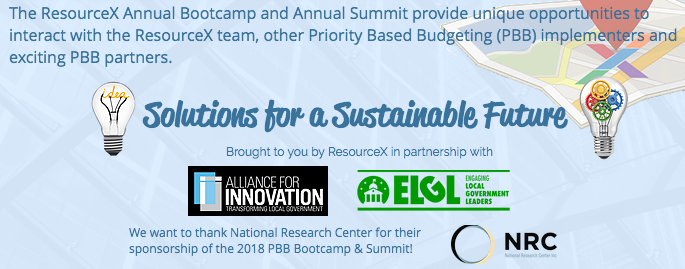"The first shift that needs to be made is to start to think about government expenditures as “community investments” — and that necessarily implies there should be a return on our public investments."
"A budget process that looks at numbers alone will help us understand the COST of everything, but the VALUE of nothing."
"At its most basic, Priority-Based Budgeting gets us to think about our programs as investments, rather than simply as costs. We want to invest our resources in programs that meet our goals, as opposed to simply continuing to fund programs that we have funded in the past.
Priority-Based Budgeting calls for us to be comprehensive and strategic in our efforts to accomplish our mission to make Marathon County the healthiest, safest, and most prosperous county in the state."
Marathon County, Wisconsin first launched Priority Based Budgeting in 2016 in development of their 2017 budget. Having furthered their practice in 2018, they are now entering their third year of budgeting through the lens of PBB for the 2019 budget.
What is unique about Marathon County is their ability to accept, communicate and deploy a "new mindset" and vision for the future of the community. This new mindset revolves around three pillars, or results, that include community health, safety and prosperity.

The idea, and central to the concept of PBB, is that the line-item budget, while an important accounting tool, is insufficient to understand if our spending is aligned with creating safer communities, healthier citizens, flourishing and inclusive economies, enabling and well-maintained infrastructure and the foundational results of society.
The fundamental breakthrough was taking each dollar we’re entrusted with, understanding how each dollar is tied to the programs we provide, and connecting those programs with the Results they influence. And this is exactly what is happening in Marathon County! The County no longer views a line item as an "expense" but as an "investment" that "implies there should be a return on our public investments."
This is a completely new mindset, and as Marathon County Administrator Brad Karger states, "That’s a BIG GOAL, and it will never be achieved with a mindset focused exclusively on scarcity. To be successful, we need to instead adopt an investment mindset that opens the door for elected decision makers and the public to:
Question past patterns of spending
Know the true costs of providing a service
Provide clarity about what a program is intended to achieve and how we can know if we got what we paid for (Not so much asking, “What did we get for those dollars?” as “What difference did it make in our community?”)
Have transparency about what was achieved and how those results impacted our end goal of enhancing our health, safety, and prosperity"
Brad has written a new article (Adopting a New Mindset: Government Expenditures = Community Investments in Health, Safety, & Prosperity). See full article here and posted below.
Adopting a New Mindset: Government Expenditures = Community Investments in Health, Safety, & Prosperity
I’ve said it before . . .
$162.5 million is a lot of money!
That’s the size of Marathon County’s 2019 budget, which was adopted in November.
Some folks find scarcity in that figure, feeling that we’ll never have enough money to do all the things that everyone wants us to do.
But me? I see abundance.
Allow me to explain . . .
It’s become commonplace for County officials — including me — to complain about under-funded State mandates, State-imposed levy caps, and administrative rules that are out-of-date and do little but increase the cost of public services. However, I would counter:
We are not helpless victims.
While it’s true that the State makes a number of decisions for us, there are MANY decisions that we local officials can make on behalf of Marathon County — and we have MILLIONS of dollars to allocate to those decisions.
I would argue that those decisions need to start with a change of mindset.
How so? Well . . .
The first shift that needs to be made is to start to think about government expenditures as “community investments” — and that necessarily implies there should be a return on our public investments.
A budget is a financial plan for the upcoming year. For any kind of plan to be effective, you need to start with the end in mind. For Marathon County, the end we’re working toward is to:
Be the safest, healthiest, and most prosperous county in Wisconsin.
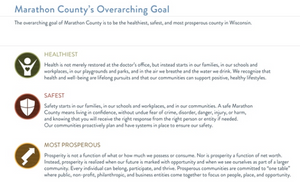
Page 2 excerpted from the 2018–2022 Marathon County Strategic Plan.
That’s a BIG GOAL, and it will never be achieved with a mindset focused exclusively on scarcity. To be successful, we need to instead adopt an investment mindset that opens the door for elected decision makers and the public to:
Question past patterns of spending
Know the true costs of providing a service
Provide clarity about what a program is intended to achieve and how we can know if we got what we paid for (Not so much asking, “What did we get for those dollars?” as “What difference did it make in our community?”)
Have transparency about what was achieved and how those results impacted our end goal of enhancing our health, safety, and prosperity
Once these pieces are in place, the stage is set for Marathon County residents to DEMAND ACCOUNTABILITY FOR THE RESULTS and to participate in a budget process that:
Links public investments to community needs and goals
Matches available resources with community priorities
Provides high-quality information that supports better informed decisions
Engages the public in a meaningful way in creating a financial plan
Public engagement in the County budget is still a work in progress. I recognize that we need to find a better way to inform the public about our budget and ask for feedback — not simply post a meeting as a public hearing and expect people to come ready to participate at a high level.
We’ve done all right at informing the public, but we’ll do better in the future at inviting their thoughts and incorporating their input into the final document.
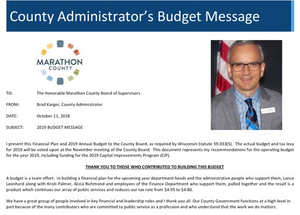
People say that a government budget is not really very different than a family budget, and they are partially right — except the numbers are a lot bigger, the time horizons are a lot longer, and there are a lot more stakeholders. But that aside, all budgets — government, business, and family budgets — distinguish between things we HAVE to do and things we WANT to do.
Let’s take a moment to think about a family where the primary income earner — we’ll call him “Dad” — loses his job and has to accept another job at a substantially lower wage. The new job can support all the things the family feels it NEEDS to do, but some hard decisions will now need to be made about things that the family WANTS to do.
To make these hard decisions, it would help if the family had agreed to some long-term goals. If they haven’t, then the “level of upset” may be the guiding factor that determines the family’s new spending behaviors.
What do I mean by that?
Well, let’s say that a long-term goal in this family is that all the kids have the opportunity to go to college and that the amount of debt taken on to achieve that goal be minimal.
If this is important, agreed-upon family goal were used as the guidepost for financial decisions — contributing to the kids’ college saving funds would go on as it had before and the family would have to learn to live without “extras” like cable television, smartphones with unlimited data plans, and dining out in restaurants.
If, however, “level of upset” were the guidepost for the family’s financial decision-making, it would be: Good-bye college-savings accounts and Can’t live without ya, cable TV, smartphones, and restaurants.
Similarly, once we as government officials know what our revenue limitations are, we can start to make choices about what is most important. Determining this can be a participative process, in which many people have a hand in defining success, allocating sufficient funds to do the important things well, and cutting back on the rest.
Marathon County Government has committed itself to move to a priority-based budgeting approach (for details, see Lance Leonhard’s newsletter article on p. 8 in this PDF). We’ve made a lot of progress toward adopting this approach to budgeting, but we’re not quite there yet. To date we have:
Engaged a consulting firm, Center for Priority Based Budgeting — now Resource Exploration, ResourceX — of Denver, Colorado, to help us create a database of all of our programs that clarifies each program’s purpose and its true cost
Grouped all of our programs into priority quadrants based on a lot of factors, including a comparison of the intended program outcomes and our goal of being the safest, healthiest, and most prosperous county in Wisconsin
Analyzed State mandates to determine what the County is required to deliver to its residents and whether the current service level exceeds that requirement in any way
Tasked the Standing Committees of the County Board to learn more about the lower priority programs to see if there are opportunities to cut back
In our discussions of the 2019 County budget, we started to use some of these concepts. Here is what happened:
The Sheriff and the local Police Chiefs identified a critical need to open a new police radio channel. That request was independently evaluated and determined to have merit. The cost of 6 new dispatcher positions needed to open a new radio channel is $350,000, which was not readily available.
The Public Safety Committee had been exploring our current operation of a Secure Detention Center (within the Marathon County Juvenile Facility) for children who are 10–16 years of age at the time of their alleged offense. That facility has a capacity to house 20 juveniles, but on average houses only 3 children from Marathon County and 3 children from a neighboring county. If we closed our facility and sent our juveniles to Portage County, we might be able to save $350,000 and re-allocate those funds to a higher priority need, like opening a new police channel. Another alternative might be to better inform other counties of our juvenile detention facility and come closer to operating at our licensed capacity of 20, thus generating $350,000 in new revenues that could be used to fund the 6 new positions needed to open a new police radio channel. The apparent consensus among our County Board members was to continue to pursue getting other counties to send us their children in need of detention, because if we closed our facility in Marathon County and the State changed the law and put 17-year-olds back into the juvenile system (currently, Juvenile court has jurisdiction over offenses alleged to have been committed prior to a child’s 17th birthday; after age 17, the youth is charged in adult court), the County would be in a difficult position, which may require re-opening the Secure Detention Facility. Also, we all agree that it’s better for kids if they have regular contact with their family, which would work best by keeping our juvenile detention facility in Marathon County.
In the past, this discussion would have been simpler —
We need more money for dispatchers:
We could just say “no” and blame State government for tax levy constraints, OR
We could allocate the funding for the 6 new dispatchers and just cut something that is not State-mandated, like the Start Right program, which provides families in Marathon County with early education and intervention services from pregnancy to age 5.
If there was a move to partially defund Start Right to fund a new police channel, a mud-slinging fight is likely to break out as each vied for the funds. That fight would not support high-impact governance. More likely it would devolve into a “guns vs. butter” debate, and County Board members would feel as though the question before them was:
Who do you love more: Our police officers or our local families?
Such a debate will not lead to a creative solution or help us move our big-picture goals forward.
Either of these “solutions” would probably not be the best option that could have been put forth had we taken a more principled approach and used priority-based budgeting to inform our decisions. That means . . .
Starting with the end goal in mind and ensuring that the people participating in the budget discussions know with clarity what all our County programs cost and what each produced. It also necessitates an engaged citizenry, ready to help us come up with a combination of “community investments” that move us closer to our long-term goals for Marathon County around health, safety, and prosperity.
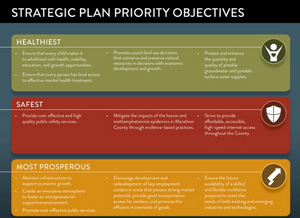
I know — it seems as though we still have a long way to go . . .
But I’m happy to report that we’ve reached consensus that a change is necessary and that priority-based budgeting is the route we’re going to take.
Further, we’ve already made tremendous progress in evolving our budget process into something more thoughtful, respectful, and transparent.
This progress has enhanced our reputation and made it easier to recruit and retain the best talent — dedicated public servants who want to work for an organization that provides its local community with well-thought-out solutions and makes (albeit sometimes hard) choices that are consistent with our values.
Additionally, our emerging budget structure makes it more likely that we can attract thoughtful people to Marathon County Government — people who want to make a positive impact on our community to serve in public policy roles.
To conclude, as I said at the outset —
$162.5 million is a lot of money!
A budget process that looks at numbers alone will help us understand the COST of everything, but the VALUE of nothing.
We’ve done enough of that. That’s not the approach I favor going forward.
Working together and utilizing high-quality information and a budgeting approach that supports:
Informed deliberation,
An engaged public, and
High-impact governance,
we can make things happen that no one ever thought possible.
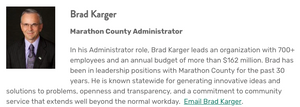
Congratulations to Marathon County, WI in their work transitioning from implementing PBB to applying PBB data for actionable decision-making! You truly have a PBB mindset and are on the right path!
Related Articles:
How Marathon County Applies PBB Data for Strategic Budgeting
ResourceX Presents "Budgeting for Economic Inclusivity" at 2019 NLC Congressional Cities Conference


